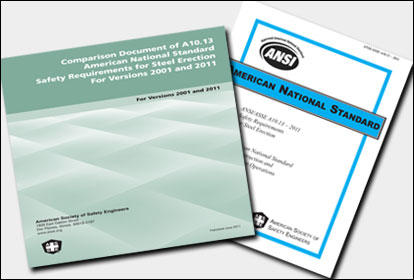Gas detection 2011: Have the rules changed?

When the editors of ISHN asked me to write an article concerning changes to gas detection in this decade, the second decade of the twenty-first century, I welcomed the opportunity to look back and explore whether or not the rules that govern gas monitoring in industry really have changed over the years.
The start of an era
The modern era of gas detection, as I like to refer to it, began nearly 20 years ago when OSHA adopted the most significant piece of legislation to ever impact gas detection: The Confined Space Act of 1993, 29CFR1910.146. For the first time, workers were required, by law, to use a real-time, “direct reading” instrument to determine if the atmospheric conditions were safe prior to entering a permit-required confined space. Similar laws quickly followed in Canada and other countries around the world. These acts, which were designed to prevent injury and death in confined space accidents, resulted in the proliferation of the use of portable gas monitoring instruments. They established the rules of the game that has evolved very slowly throughout the past two decades.
Over the years there have been several changes to accepted standards for limiting worker exposures to hazardous gases on the job such as the reductions in the ACGIH TLV recommendations for sulfur dioxide and hydrogen sulfide exposure in 2009 and 2010. But these rule changes, like other similar guidelines for limiting a worker’s exposure to hazardous conditions, are designed to eliminate the long-term health effects of gas exposure and do not carry a requirement for anyone to use a portable gas detector.
Disaster drives change
Unfortunately, significant changes to laws governing and mandating the use of gas detection instruments have generally been driven by tragedy. The mining industry, where there were requirements for using gas monitoring instruments long before 1993, made sweeping changes to regulations following the explosion at the Sago mine in West Virginia in 2006 that killed 13 miners. The new Mine Safety and Health Administration (MSHA) regulations required every manned crew working underground and every miner who may be working alone to carry a multi-gas monitor capable of detecting levels of methane, oxygen and carbon monoxide. Mine operators were also required by the new rules to regularly measure and record the levels of gases behind mine seals to ensure that the atmosphere is inert and not capable of exploding. These regulations were responsible for putting thousands of new gas monitoring instruments into service in the mining industry.
On November 15 of this year, legislation enacted by the Bureau of Ocean Energy Management, Regulation and Enforcement (BOEMRE) under 30CFR250 will take effect. The BOEMRE controls offshore operations in U.S. territorial waters. The new legislation, designed to protect both workers and the environment, is in response to the catastrophic explosion on the BP Deepwater Horizons platform that claimed 11 lives and spilled more than 205 million gallons of crude oil into the Gulf of Mexico. The law - derived from American Petroleum Institute (API) safety standards that were developed originally in 2002 - requires detection of various hazardous gases, hydrogen sulfide in particular, and has strict requirements for both calibration and bump testing of equipment that is not seen in other regulations. Although these rules will initially apply only to offshore operations, it is widely believed that the laws will also be applied to land-based petroleum operations in the near future. Unfortunately, the API standards that originated nine years ago were never regulated until now.
These disasters show that as manufacturers and suppliers of gas detection equipment to industry, we can produce the highest quality, most reliable products possible. But if the rules governing their use are not in place and are not rigorously enforced, these incidents likely will not be prevented. The confined space entrant cannot be protected if his gas monitor rests helplessly on the dashboard of his truck. The coal miner will not be saved if the detector she carries on her belt remains turned off. The group of refinery contractors will all be lost if the instrument designed to save their lives, screaming in alarm of danger, is blatantly ignored. Even after the implementation of strict regulations following the Sago mine explosion, 29 miners failed to come home as a result of the April 2010 Massey Energy Upper Big Branch Mine explosion.
Three unwritten rules
In the midst of these changes, there are three unwritten, unlegislated rules of gas detection which I personally live by that will withstand the test of time and will protect the lives of gas detection equipment users if they are followed consistently. 1. Calibrate your instruments regularly; 2. Bump test habitually; and 3. Review data routinely.
1 Calibrate your instruments regularly.
Instrument calibration sets the accuracy of the monitor and establishes a basis for trust in its readings. This should be done on at least a monthly basis or even more frequently if your monitor is used in harsh conditions that stress the unit and its sensors.
2 Bump test habitually. Every day.
The only way that you will know that your gas detector will actually detect gas is to test it with gas each day before you use it. One in every 250 gas monitoring instruments in use will fail a bump test every day. Do you want to take the chance that the unit you are carrying is the one that will fail to detect gas when you need it to? It is simple. It is quick. Make it a habit.
3 Review data routinely.
Hidden within your gas monitor is data that paint pictures of the conditions that existed when and where it has been used. These pictures may reveal conditions that might likely become catastrophic. Routinely reviewing the data from your instruments and uncovering what you do not know will allow you to correct unsafe conditions before they turn into tragedy.
I do not know if we need to implement more laws and change more rules relating to gas detection to eliminate death in the workplace due to gas accidents. I do know that if we pay more attention to the rules that are already in place, take the time to understand the data that we accumulate, have stricter enforcement of the existing laws and greater accountability for the consequences of not following them, we will be safer in the next decade than we are in 2011.
Looking for a reprint of this article?
From high-res PDFs to custom plaques, order your copy today!






